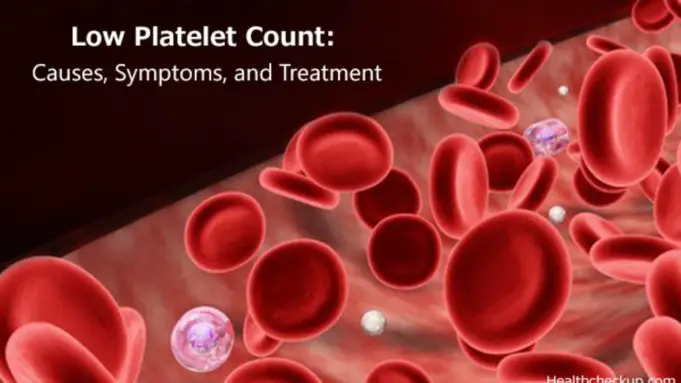The blood is made up of different cells that float in a liquid known as plasma. The blood cells types are;
- White blood cells
- Red blood cells
- Thrombocytes or platelets
Low platelet count or thrombocytopenia is a condition that occurs when you have reduced or low platelet in your blood. This condition can affect the ability of the blood to clot when you sustain an injury or wound.
Depending on the cause of this condition, it could range from mild to severe and can affect both adults and children.
Understanding thrombocytes and how they stop bleeding
Thrombocytes are a very crucial part of the blood composition. They are produced in the bone marrow and are not visible to the naked eyes.
Thrombocytes or platelets play an important role in the blood clotting system and repairing of damaged tissues.
When your blood vessel wall is damaged, the substance that activates platelets becomes exposed. The activated platelets releases sticky proteins (fibrin) that helps to form a mesh of threads that plug the leak together.
Signs and Symptoms of Low Platelet Count
Mild cases of this condition may not really cause any symptoms. But severe cases may lead to uncontrollable bleeding which needs immediate medical attention.
Some visible symptoms of low platelet count include;
- Purpura(purple, red, or brown bruises)
- Prolonged bleeding from wounds that does not stop on its own.
- Bleeding from gums
- Blood in stool or urine
- Bleeding from nose
- Petechiae (rash with a small red dot or reddish-brown bruises)
- Very dark or blood in vomit
- Very heavy menstrual flow or bleeding
Some rare symptoms of this condition may lead to internal bleeding or bleeding in the brain.
Causes of Low Platelet Count
Thrombocytopenia is a condition that is rarely inherited. It can be caused by a number of factors ranging from an underlying condition to medications and more.
Below are some causes of low platelet count.
1. Trapped Platelets
The spleen helps to filter waste materials from the blood and also fights against infections. However, an enlarged spleen can trap too many platelets and cause the number of platelet circulation to decrease.
2. Platelet Destruction
In a healthy body, a platelet lives for about ten days. Certain conditions may cause the body system to use platelets faster than they are produced. This can lead to platelet shortage in the bloodstream.
Some of these conditions include;
- Immune thrombocytopenia: A condition that occurs when the body’s immune system destroys platelets
- Medication: Some medications may cause the immune system to destroy platelets and can lead to a reduction of platelet count in the blood.
- Bacterial Infection: Many bacterial infections involve blood and can lead to a reduction of platelet count.
- Hemolytic uremic syndrome: A rare condition that causes the platelet to drop massively, destroy red blood cells, and can also weaken or diminish the kidney functions.
- Pregnancy: Low platelet cause during pregnancy is not usually dangerous or serious as it improves after childbirth.
3. Bone Marrow Problems
The bone marrow is located inside the bone. It is a spongy-like tissue, where all blood components are being produced including platelets or thrombocytes. When the bone marrow does not produce enough platelets it will result in low platelet count.
Some medical conditions that can lead to a decreased platelet production include;
- Deficiency in vitamin B-12
- Deficiency in iron
- Deficiency in folate
- Leukemia
- Too much alcohol consumption
- Exposure to toxic chemicals or radiation
- Infections such as chickenpox, HIV and Epstein Barr
- Myelodysplasia
Diagnosis of Low Platelet Count
Low platelet count diagnosis is carried out a doctor. First, the doctor will carry out a physical exam, and ask questions that may cover recent medications, family history as well as questions that will cover symptoms.
When conducting the physical exam, the doctor also checks for petechiae (rash with a small red dot or reddish-brown bruises).
An abdominal check using ultrasound may also be a part of the physical exam. An abdominal check is done to observe the spleen whether it is enlarged since an enlarged spleen is a cause of low platelet count.
To confirm the diagnosis the doctor will ask you to do a blood test. This will tell the doctor if your platelet concentration is lower than normal. Some laboratory tests that may be recommended for you may include;
- Bone marrow test
- Blood smear test
- Complete blood count(CBC) test
Bone marrow biopsy and aspiration may be carried out as well. This involves using a needle to take samples of core bone marrow especially from the hip bone(bone marrow biopsy) and using a needle to take a sample of the small amount of bone marrow(bone marrow aspiration).
Both the bone marrow aspiration and biopsy are done at the same time.
Possible Risks and Complications
Low platelet count left untreated may lead to a severe internal bleeding. It can also lead to bleeding in the brain.
Treatments of Low Platelet Count
Low platelet count treatment depends on the cause of the condition and how severe it is. You may be asked to take preventive measures to avoid worsening the condition.
This includes;
- Reduce alcohol intake.
- Avoid activities that will result to bruises or bleeding.
- Avoid exercising and sports.
- Stop or switch some certain medications that affect blood platelets such as ibuprofen and aspirin.
A more severe condition may require medical treatment such as;
- Blood transfusion.
- Immune globulin
- Steriods
- Surgery to remove spleen.
- Corticosteroids to block platelet antibodies.
References;
- Thrombocytopenia; Wikipedia
- Thrombocytopenia (low platelet count); Mayo Clinic
- Thrombocytopenia and ITP; WebMD












